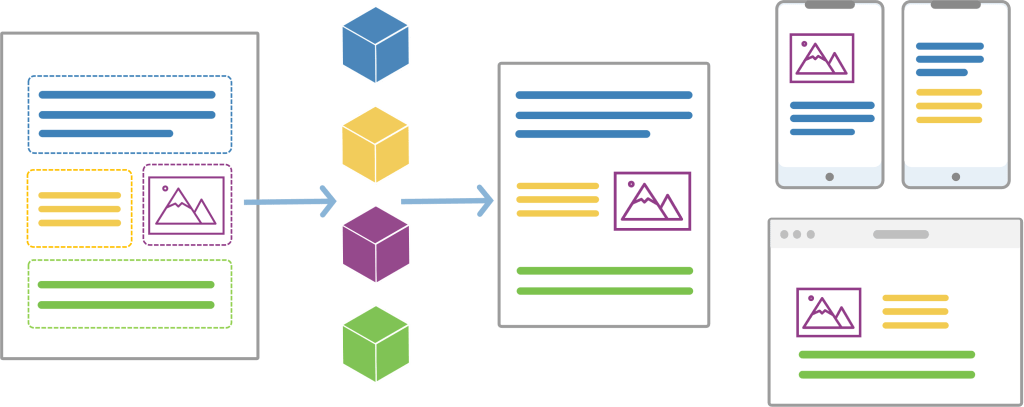Modular design has brought a paradigm shift in the realm of content management by offering an effective way to handle content that is adaptable, scalable, and future-proof. Due to the growing significance of omnichannel strategies and the soaring demand for content, modular design has become an indispensable element for any prosperous content management system.

"Modular content is the root of our adaptability for rapid and agile distribution — it’s huge for our business — and centralized management of branding for our outputs has been a game changer for us."
Through this blog post, we will examine the advantages of modular design and demonstrate how it can streamline content creation, distribution, and management. We will address the top ten questions that arise while implementing a modular content strategy and analyze the role of technology in supporting a modular approach.
So, get geared up to master the ins and outs of modular design in content management and produce content that is cohesive, scalable, and consistent.
Making the Most of Modular Design in Content Management

The content world is evolving, and with it, our approaches to managing information are changing, as well. Enter modular content design, a standout feature in centralized repositories. Modular content design is based on building blocks of information, ready to be used wherever needed. By compartmentalizing content into these modules, storage is simplified, and accessibility increases. Plus, a modular design means content can be reshuffled, reused, and recalibrated to fit different needs.
Reusability is a key advantage of modular content design. Create content once, and it can be woven into different courses or tailored for varied learning goals. This approach ensures that learners get consistent materials and organizations save precious time, by not reinventing the wheel.
In the big picture, when content demands grow, and resources are at a premium, a centralized repository championing modular design is a game-changer. It paves the way for streamlined content handling, ensuring learners get top-notch information, delivered efficiently.
Invest Now, Grow for the Future
As organizations grow and diversify, so do their L&D needs. Here's where a centralized content repository shines, designed with adaptability in mind. Such systems are adept at absorbing new content and courses without missing a beat, making sure that more content doesn't equal more hassle.
But the true value of an LCMS lies in its flexibility. When it's time to integrate the latest learning tech, there's no need for a complete overhaul. New tools fit right into the existing setup, enhancing the learning journey rather than complicating it. A centralized repository grows with an organization, ready to meet future L&D challenges head-on.
There’s a certain peace of mind knowing that today's investment will stand the test of time. It gives confidence to stakeholders and decision-makers alike. This forward-thinking strategy syncs perfectly with ambitious organizations, ensuring their L&D tools and tactics align seamlessly with their broader goals.
Given the often demanding nature of content creation, it's clear to see why a centralized repository that embraces modular content is so valuable. It streamlines content management, ensuring learners get consistent, top-tier information with minimal fuss.
Top Ten Questions to Ask About Centralizing Your L&D Content Repository
Agile organizations are always on the lookout for ways to streamline Learning and Development processes and improve efficiencies. One of the key components that’s often overlooked is the importance of a centralized content repository. But how do you know if it's the right move for your organization?
Why it matters: Fragmented learning materials can lead to inconsistent messages, potentially confusing or misinforming your learners. A centralized system guarantees consistency, ensuring all learners receive the most updated and accurate content, regardless of access point.
Why it matters: Updating content across multiple platforms can be a logistical nightmare. A centralized repository streamlines this process, ensuring updates are made once and reflected everywhere, saving time and avoiding discrepancies.
Why it matters: If your content is scattered, learners may struggle to find what they need. Centralization improves search capabilities and accessibility, making the learning experience smoother and more user-friendly.
Why it matters: Centralized systems can provide holistic data on content usage and learner performance. This data drives informed decisions about content creation, course design, and learner needs, optimizing the L&D process.
Why it matters: Fragmentation can lead to content delivery issues. Centralization ensures content is seamlessly integrated across various platforms, from LMS to knowledge bases, enhancing the learner experience.
Why it matters: Maintaining and updating content across multiple systems can be costly. Centralization is cost-effective, consolidating resources and focusing on a unified repository, which in the long run, saves money.
Why it matters: Modern learners prefer bite-sized, on-the-spot content. Centralized systems are better equipped to store, manage, and deliver these microlearning modules efficiently.
Why it matters: Modular content design, supported by centralized repositories, ensures content chunks created for one course can be repurposed elsewhere, ensuring consistency and reducing duplication of effort.
Why it matters: AI-driven features, like content tagging and personalized learning paths, are easier to implement in a centralized system, making your L&D processes cutting-edge and efficient.
If you are nodding in agreement with these questions, it may be wise to consider centralizing your content repository. A centralized approach is not just a logistical solution—it's a strategic move that can transform your L&D initiatives, making them more efficient, scalable, and attuned to the modern learner's needs. Before making any decisions, evaluate your current ecosystem, ask the right questions, and prioritize a system that aligns with your organization’s long-term L&D vision.
Our Customers Have Powerful Journeys
Explore our insightful customer stories to see how our solutions have helped organizations like yours achieve tangible results.





